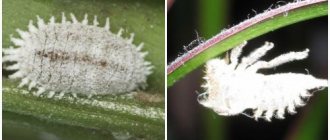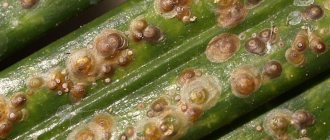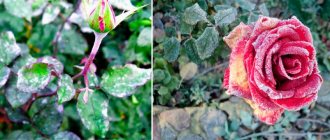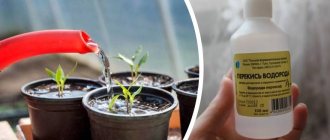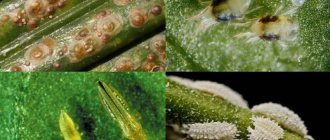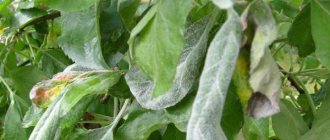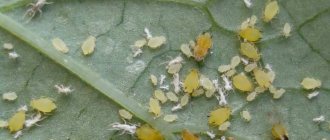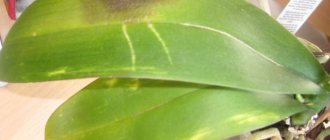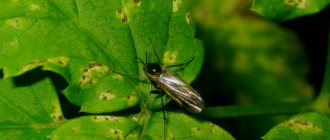Author: Elena N. https://floristics.info/ru/index.php?option=com_contact&view=contact&id=19 Category: Plant Pests Published: November 07, 2017Last edits: October 26, 2020
- Fighting thrips on cucumbers
Thrips (lat. Thysanoptera), or vesicopods (fringed-winged, club-footed) are a group of small-sized insects common on all continents. Thrips were first described in 1744 by Karl de Geer, and today more than 6,000 species of these insects have been identified, grouped into more than a hundred genera.
How to fight thrips on houseplants
Thrips on indoor plants: how to fight them in this protracted war? Agree, you don’t always win the battle with a pest. Thrips, unpleasant and dangerous insects, have many species that differ significantly from each other not only in size, but also in color. They attack the plant mainly with their numbers, because each individual reproduces every 6 days, doubling the colony. Therefore, the fight against them is difficult and lengthy. It seems that all the thrips have been destroyed, but after a couple of weeks they again draw all the juices out of the plant. The flower weakens and withers right before our eyes.
Characteristics of thrips
Insects attack both agricultural and ornamental crops. They are omnivores, but especially love flowers.
Microscopic, invisible bugs cause significant harm:
- They suck the juice out of plants, weakening them and leading to death;
- By settling on flowers, they prevent the formation of ovaries and the growth of fruits;
- They are carriers of viral diseases.
The vast majority of species feed on plant sap and are therefore dangerous pests of agricultural plants. However, there are predators that hunt aphids, spider mites, and small herbivorous relatives. They are used in pest control, being an environmentally friendly method.
What do thrips look like?
The most numerous insect pest species is thrips. Their size ranges from 0.5 mm to 5 mm. The color can also range from transparent milky individuals to black. The body is oblong, has two wings with a fringe characteristic of these insects located along the edge of the wing.
Indoor thrips species have a size of 1-1.5 mm. The appearance of insects can vary significantly even within the same species.
thrips varieties
The laid larvae are similar in appearance to the adults, but their color is usually translucent white or light yellow. They do not have wings, unlike adult insects. The most common and well-known types:
- Frankliniella intonsa is a multivorous thrips that damages the developing ovaries and flowers of the plant.
- Hercinothrips femoralis is an ornamental thrips that likes to settle on large plants such as amaryllis, chrysanthemums, callas, cacti and gardenias.
- Parthnothrips dracaenoe - dracaena thrips, spoils aralia, tradescantia, dracaena, hibiscus; Thrips fuscipennis - This thrips prefers forbs.
- Thrips tabaci - tobacco thrips; its name makes its preferences clear.
- Liothrips vaneeckei is an onion thrip that loves to eat gladioli bulbs.
Insects feed on the sap of the plants on which they settle. The paths that they gnaw in the tissues of leaves eventually become visible to the naked eye. In room conditions, the number of individuals doubles every 6 days.
Thrips pest - description
The length of the black, brown or gray body of thrips reaches from 0.5 to 3 mm, some species are much larger - about 14 mm. The legs of thrips are running, the mouthparts are asymmetrical, piercing-sucking, and the paws are without claws, but are equipped with teeth and a bubble-like suction device. The abdomen of thrips consists of 11 segments. There is fringe along the edges of the wings. Thrips develop through five stages: eggs, larvae, pronymphs, nymphs and adults. Thrips larvae have a grayish or white-yellow body, otherwise they differ from adults only in the absence of wings.
Thrips are polyphages, that is, omnivorous insects. They are one of the most common pests of agricultural, vegetable, fruit, ornamental and indoor crops. They pose a particular danger to plants indoors: if thrips are infested in greenhouses, it is very difficult to get rid of them; you can only contain their population numbers. It is difficult to detect these pests due to their small size and secretive lifestyle: they can parasitize one plant for a long time without spreading to neighboring ones.
Adults and larvae suck the sap from the above-ground parts of the plant and infect them with their secretions. First, discolored or yellowish spots, streaks or stripes appear at the bite sites, which gradually merge. As a result of the activity of pests, plant tissue dies, holes form in place of the spots, leaves wither and fall off, flowers lose their decorative effect and fall off prematurely. When a plant is massively occupied by thrips, silvery areas appear on its ground organs, the stems are bent, and the flowers are deformed due to the fact that the pests have damaged the flower buds. On top of that, thrips are carriers of incurable viral diseases.
- Nematode
Thrips on indoor flowers
Thrips love “thoroughbred” plants. Flowers such as:
- rose;
- dracaena;
- ficus;
- laurel;
- monstera;
- lemon;
- palm.
Although the insect can feed on any indoor plant. When infected with these harmful insects, the leaves of the plant begin to lighten. Numerous punctures appear from the thrips' voracious trunk.
plant leaf affected by thrips
At the same time, brown spots appear on the inside of the leaf. When insects attack a plant, they destroy the leaves and begin to die. Flower buds become deformed and inflorescences take on ugly shapes.
Criminal traces! If you carefully examine an indoor flower, you will see pollen spilling out from the stamens of the flowers on the leaves. This is a clear sign that a colony of thrips has settled on the plant. Although this can happen when the flower is shaken or infected by one of the types of mites.
To recognize the cause of pollen shedding and make sure that thrips are present or absent, pick a flower. Tap it lightly with a pencil or ballpoint pen on a dark-colored sheet of paper. This method will show whether the plant is infested with pests.
You can also experimentally determine what type of “beast” has settled on your pet. Perhaps a greenhouse or ornamental thrips has settled on the flower. Symptoms of thrips and flat mite infestations are very similar. But please note that thrips are harsher than ticks.
Over time, these pests will turn your gorgeous pet into an obvious ragamuffin with terrible “scars” on the leaves and barely alive flowers that are in the last stage of exhaustion. Petals speckled with dark and light spots, half-withered and deformed flowers evoke pity, not delight, when looking at them.
There are also types of thrips that have only one generation per year; these are usually local species brought into the home by the wind, or with flowers from the garden plot. Such species are peaceful in nature and will disappear from the “battlefield” by autumn.
You should be afraid of the appearance of California thrips on house flowers, a very harmful eater of indoor specimens.
Damage to plants by different types of thrips
The body of the pest is elongated, up to 2 mm, color varies (usually inconspicuous - light yellow, dark brown or black). Adults have 2 pairs of narrow wings with long hairs. Depending on the type of thrips, the length of the wings varies, some have no wings. The head has antennae consisting of segments (on average 9 segments). The mouthparts are piercing-sucking type. The size of the light yellow larvae is no more than 1 mm.
Mature individuals move very quickly thanks to 3 pairs of legs located in the thoracic region. Each foot has 1 tooth and 1 suction bubble-like device.
Thrips
They reproduce actively, capable of doubling the size of their population in 4-6 days. Places for egg laying are flowers and leaf tissue. The offspring hatch after 10 days. The larva develops into an adult insect in 1-2 months. Because of this short developmental cycle, some species are able to produce several litters within a year.
These pests have habits characteristic of social insects. Like ants and termites, they work together to guard their eggs. In addition to sucking juice, thrips carry all sorts of viruses that are dangerous to plants.
It is quite difficult to recognize belonging to a specific species, since the parasites are small and their species variability is very common.
Common types of thrips that damage ornamental plants:
| Name | Body length | Color | What amazes |
| Western Floral or California Floral | 0.9-1.2 mm | From pale yellow to dark brown. The bristles on the body are dark, the wings are light yellow | Carnations, gerberas, gypsophila, pelargoniums, roses, saintpaulias, chrysanthemums, cyclamen and cineraria |
| Tobacco | 0.8-1.2 mm | Females are lightish yellow, sometimes dark, their antennae and legs are grayish, their wings are yellowish and occasionally light gray-yellow. Males are slightly lighter in color | Solanaceae, umbelliferae, ranunculaceae, rosaceae and lilies |
| Decorative | 1.1-1.7 mm | The female is yellow, then turns brown and black. The wings are darkish, with light spots at the base and on the tips of the wings. Males are lighter | Crassula (money tree), orchids and palm trees are especially damaged. This pest can destroy monstera and dieffenbachia |
| Bulbous | 1-2 mm | Dark brown | Regular onions, as well as onion scales from different types of lily plants |
| Rozanny | Up to 1 mm | Brown | Flowers of Rosaceae and some other plants |
| Palm | 0.8–1.4 mm | Bright yellow, almost transparent, with blackish bristles. Head and legs light yellow | Solanaceae, various types of orchids |
| Dracaena | About 1mm | Yellow-brown | Dracaenas, hibiscus and ficus |
| Divorceous | About 1mm | Dark brown | Flowers and ovaries of ornamental plants |
Where do thrips come from?
Forewarned is forearmed! In the summer, flower pests easily penetrate into a person’s home with gusts of wind, with soil brought from the garden plot. When buying new varieties of house plants, you also run the risk of introducing pests into your home; there is no insurance against infection spread by thrips.
With onions brought from the dacha, California thrips gets into the house. Summer, a time of intensive exchange between gardeners with rare house plants, then? there is a danger of infection. At this time, flowers are often moved to balconies and loggias protected from the wind, but with drafts, when ventilated there is still a risk of catching thrips.
California thrips
Summer, heat and dry air are favorable conditions for the spread of this evil pest. He loves high summer temperatures. As the weather gets colder, the intensity of thrips distribution drops significantly.
Why are thrips dangerous?
Thrips love flowers, but in indoor plants it is much easier to recognize them by their leaves. Pests do not sit on one plant for long, quickly move to neighbors, hide in the soil and are almost invisible.
Feeding on the sap of a plant from the larval stage until death, thrips not only suck the life force out of it, but also infect it with their secretions. They pierce the leaf tissue, leaving elusive light, whitish-cream dots and streaks that merge into bleached, chaotic patterns. Specks, strokes, stripes are easier to see on the back surface; on the top they appear as a heterogeneous silvery-milky-matte coating.
The death of tissue at the puncture sites and the effect of an uneven bluish film are not immediately apparent, but gradually expanding patterns cover an increasingly larger area and lead to serious damage. Dry spots and areas appear on the leaves, they turn brown and dry out. On flowers, thrips punctures are less noticeable, but they deform much faster. Thrips do not even spare the shoots, which also gradually become covered with small spots and become distorted.
The depressed state of the plant, stunting of growth, rapid flowering, dying and shedding of leaves and flowers is a sad result of the life activity of thrips.
The best assistant in diagnosing thrips is a magnifying glass. If suspicious light “scuffs” and uneven coating are noticeable on the leaves of a plant, it is worth examining them through a magnifying glass to notice insects that are almost constantly on the move.
When they say that thrips cannot be exterminated, but can only be controlled, they usually mean winter gardens and greenhouses, where it is indeed very difficult to control insects. It's worth fighting this ravine in the rooms, because the chances of success are much higher.
The result of the life activity of thrips. © amazingherbgarden
Thrips control
Whatever plants become infected with thrips, preventive measures should be taken. Strictly monitor air humidity, pests cannot tolerate moisture. In the summer, give your green pets a shower, with soap foam, preferably from baby soap. This is an almost 100% guarantee against this malicious pest.
Be sure to conduct a visual inspection of your indoor garden once a week. You will admire your flowers and at the same time inspect them for infestation, both pests and any infection.
Stock up on adhesive tapes to place them among the leaves of plants; this is also a preventive measure in pest control. Everyone recommends using your own ribbon color; some say that thrips are best caught on pink, while others recommend blue.
Who claims that only the yellow color of the trap is suitable for catching pests? Thrips have wings, which means they can easily migrate from plant to plant. This is the reason for the rapid infection of green pets in the same room.
A fight for life and death! Thrips are persistent individuals and are extremely difficult to fight, mainly because they lay eggs inside the leaf. Since they are protected by fibers, they are practically indestructible; neither pesticides nor any other means take them.
thrips larva
Thrips love dry, hot air; at a temperature of +20-25˚C they double their numbers every 4-5 days. Just imagine what hordes of greedy and hungry pests these are. If you don't fight them, they will destroy everything that blooms and grows in the house.
If you find thrips on at least one plant, inspect the nearby flowers and give all your pets an urgent wash with soapy foam. This is prevention. Be sure to place the infected plant in quarantine, let it stand in a room separate from other seedlings, and you will observe it at this time.
The place where the infected pet stood? The top layer of soil in the pot should be removed and the substrate needs to be replaced. It should also be sprayed with insecticides. Before cultivating the soil, the plant should be given a shower; this will not harm it.
Note! Treatment with a soap solution is not a panacea; it is better to treat the plant with chemicals. Thrips are very difficult to destroy, so chemistry is better than the soap solution often used by gardeners.
Prevention of plant infection
Maintain constantly high air humidity. This is ideal prevention and protection against thrips at any time of the year. In indoor conditions, if possible, it is better to isolate plants affected by thrips from healthy ones.
Transfer plants very carefully: with a slight shaking, larvae and adults easily fall from flowers and leaves and can wait a long time to settle on the plants again. The place where the plants affected by thrips stood should be washed thoroughly.
It is also advisable to remove the topmost layer of soil from affected plants in flower pots, as thrips larvae may be present there.
At the time of treatment, it is very advisable to remove all flower stalks and affected leaves on the plants. Three to four treatments will be required at intervals of 7-10 days. When treating indoor plants against thrips, you can use a large plastic bag.
Place the pot with the plant in it, sprinkle it and close the bag tightly for 2-3 hours. This method is also good in the fight against spider mites. The only way to get rid of thrips is to carry out a series of treatments with systemic insecticides, for example, Fitoverm, Actellik (the safest for use at home).
In greenhouses, greenhouses or in open ground, you can use Vertimek, Agravertin, Iskra, Mospilan, Aktar, and solutions of these drugs can be used not only for spraying, but also for watering at the root.
The combination of increased concentrations with a slight addition of anti-flea pet shampoo is quite effective. In the fight against thrips, the new drug Spintor, which is an insecticide of natural origin, has proven itself to be highly effective. Spraying with Spintor is carried out strictly according to the instructions with an interval of 7-10 days.
It is easier to prevent thrips from appearing than to get rid of them later. Therefore, indoor plants need to be inspected frequently. Most often, flower thrips appear when the soil is insufficiently moist. Therefore, it is important to regularly water and spray the flowers.
The soil for them, collected independently, must be sterilized, since it may contain the larvae of these pests. To do this, you can use special preparations “Nemabact” or “Antonem-F”.
An insect can enter a house with any flowers: purchased in a store, collected in a field or in a country house. Therefore, in this case, it is better to place the bouquet or pot separately from other plants. It is better to replant the purchased flower in another soil and in a clean pot.
In apartments located on the lower floors, thrips can fly into an open window. To catch insects that accidentally enter the house, you need to hang special bright sticky traps. It must be taken into account that adults move very quickly, and larvae can live outside the plant for a long time.
To prevent thrips from landing on indoor plants, you can regularly spray them with decoctions of strong-smelling plants: marigolds, celandine, tobacco and others. They will not harm the flowers, and insects cannot stand the smell.
In order for indoor plants to always please their owners with a healthy and blooming appearance, it is necessary to pay more attention to them. Regular water treatments will help prevent pest infestation and save a person from long-term struggles with insects.
Remedies for thrips
In war, all means are good! Products used for spraying plants often require additional actions, such as covering the flower with a plastic bag for a day. So, get to know these drugs:
- Vertimek - dilute 2.5 ml of the drug in 200 ml of water, spray the infected flower with this solution and cover with a bag.
- Fitoverm - dissolve 2 ml of the drug in 200 ml of water, and spray the plant, covering it with a transparent bag for a day.
- Aktelik - dilute 1 ampoule in 1 liter of water, the solution has a very pungent odor, it is better to process it in the fresh air. Spray the plant and cover with a bag.
- Agravertine - take 5 ml of the drug for half a liter and dilute it in warm water not lower than +18˚C; at low temperatures it does not saturate plant tissues well. Treat the flower with the prepared solution and again cover it with a bag for a day.
- Confidor - the soil of an infected flower is treated with a solution.
- Kabofos is a proven remedy for pest control; it is also used on the plant substrate.
- Intavir - dilute 1 tablet per 10 liters of water, spray the plant with it, cover with a plastic bag.
After 24 hours, remove the covering bags from plants treated with one of the listed preparations. Spraying should be done every ten days of the month until the pests are completely destroyed.
Biological description of the pest
The Thrips or Bladderfoot family, lat. Tripidae (Physapoda), belongs to the order Thrips or Fringed-winged, lat. Thysanoptera, from the class Insects, lat. Insecta. Distributed throughout the globe where plants exist. More than 200 species are found in Eurasia. Many of them are pests of plants grown by humans:
- Bulbous thrips, lat. Liothrips vaneeckei;
- Tobacco thrips, lat. Trips tabaci;
- Thrips barrens, lat. Haplothrips aculeatus$
- Bread thrips, lat. Limothrips cerealium;
- Thrips heterovorous, lat. Frankliniella intosa.
Most species are very small in size and have a similar body structure. It can be considered using the example of tobacco thrips, which is a pest of more than 100 species of plants cultivated by people.
Structure
The insect's body is small. Its length is from 0.8 to 1.5 mm, it is narrow and slender. Body color ranges from light yellow to brown. Due to the sloping forehead and lower lip, the triangular shape of the head resembles a cone, with its apex facing downwards.
The mouthparts are located on the head and are of the piercing-sucking type. There is a groove on the inside of the lower lip. Three bristles move along it. At their core, they are modified lower jaws. One, unpaired seta, pierces the tissues of the host plant. Two paired bristles widen the puncture and serve as a kind of tube for sucking out plant juices. There is also a pair of antennae on the head. Each of them consists of seven segments.
The prothorax is free. The mesothorax is fused with the metathorax. The pest's abdomen has 11 segments.
The tobacco thrips has three pairs of two-segmented limbs. They got their name bladderlegs because at the base of each limb there is a small, bubble-like swelling. The front pair of legs are yellowish in color.
The insect has four narrow wings. They are transparent, slightly yellowish. Their edges are decorated with fringe. Another name for the pest is associated with it - fringed winged. The veins on the wings are few in number.
Sexual dimorphism
Female tobacco thrips are larger than males. Their color is usually darker. This is especially true for spring females. Females have a saw-toothed ovipositor. They live longer than males. Only males are born from unfertilized females. During sexual reproduction, the number of females begins to predominate.
There are cases where males have reduced wings. Although individuals of both sexes can appear without wings.
How to deal with pests at home
On the forums they talk about how to combat flower pests at home:
- Collage advises: spray the plant with condifor, and writes that he is amazed at the result. After treating the flower with the solution, by evening the thrips fell off dead and he never saw them on the plant again. The solution was prepared in the following proportion: 1 gram of the drug per half-liter jar of water.
- Kroki: got rid of thrips using the drug phytovert. A one-time treatment was enough, but to calm your conscience, you can do one more. Some time after the destruction of the “conquerors”, the plant should be supported with epin.
- Natali advises: if signs of a plant becoming infected with thrips appear, cut off all flower ovaries. They are still deformed; pests will “help” them with this. It's difficult to fight them. The plant must be treated several times, possibly several times when the larvae emerge into the “light.” Therefore, about 5 treatments are carried out to destroy the entire thrips colony. You cannot leave even one pest alive.
How to act correctly when treating with chemicals?
Chemicals are dangerous in their pure form for humans and animals. It is better to put the purchased product out of the reach of children and animals before use. Before use, it is recommended to study the instructions and dilute the product in the required proportions according to the rules.
Treatment is carried out in a well-ventilated area or outdoors if the thrips attack occurred in warm weather.
It is necessary to protect the respiratory organs with a mask (in extreme cases, use a scarf or gauze), and put gloves on your hands.
If the processing period occurred in the winter, then it is better to process the flowers in the bathroom. After spraying, it is not recommended to take out flower pots immediately; it is better if they stand behind a closed door for several hours.
It is prohibited to use products in the presence of children.
After completing the treatment procedure on indoor flowers (it will not be possible to get rid of thrips the first time, you will need a second one), it is recommended to wash the floors. It is necessary to remove any remaining product from the floor and possible fallen larvae, and also wash your hands with soap.
The treatment procedure must be repeated after 1-2 weeks, but if after the second treatment the pests have not disappeared, then you immediately need to change the product and repeat the entire process of spraying with poison in a new way.
How to destroy a pest
Strategic offensive plan! In the initial stage of flower infection, it is possible to fight the pest by spraying it with infusion of tobacco, hot pepper, and soap solution. But these are weak “medicines” against thrips; they can rather be called preventive than curative.
This pest is persistent and it is very difficult to get rid of it with weak infusions. Better use insecticides. In the fight against thrips, natural remedies recede; only chemistry can cope.
At what temperature do thrips die?
The optimal temperature for the development and life of thrips ranges from +15 to +30˚С. At the egg stage, too high a temperature is not required, since it tends to dry out and then die, +20-25 degrees, the best conditions for eggs.
Then comes the time of the larvae, at +27˚C it begins to molt. Five days is enough for her to reach the size of an adult; after molting, she turns into a protonymph.
thrips nymph
High temperature +27˚С promotes rapid (within 24 hours) transformation into a nymph. After three days she is already an imago, and a day later the mature thrips will make its first flight.
An individual lives for a month or a month and a half, the lowest temperature of the pest’s existence is +9.5˚C. Below the temperature is not acceptable for this aggressor; at zero or below the thermometer mark, death awaits him. It overwinters in the soil in the adult stage.
Home and chemical control methods
First of all, it is necessary to isolate the flower infected with thrips, replace the surface layer of soil and treat the place where the flower pot was previously located with a soap-alcohol solution.
Remember!
Moving the container must be careful so that the parasites do not spill out and then migrate to neighboring plants. Next, taking into account the degree of damage, you can choose methods of control.
Chemical means
Although manufacturers offer many effective chemicals, not all of them will help get rid of the pest. There are several reasons:
- thrips hides in hard-to-reach places for penetration of sprayed substances;
- females lay eggs inside plant tissues;
- pupae often end up in the soil;
- eggs and nymphs have a protective covering that protects them from the effects of contact insecticides (they are best used on decorative foliage plants and various flowering species, but before the budding phase).
Can be used:
- Akarin and Fitoverm (toxicity class VI - low danger to humans and animals);
- Aktara, Inta-Vir, Konfidor Extra, Tanrek, Spintor, Agravertin, Karate, Bankol and Karbofos (III class - moderately dangerous);
- Actellik and Vertimek (Class II - highly dangerous).
The last two products are especially toxic, and Karbofos has a very strong and unpleasant smell. Therefore, processing should only be done outdoors. It is recommended to first use the more environmentally friendly biological product Fitoverm, and then the growth stimulator Epin.
Before treating with one or another insecticide, you need to wash the plant under a warm shower. The drugs must be used in personal protective equipment, having carefully read the instructions and recommendations of the manufacturers.
| Number of treatments | Average daily air temperature | Interval between treatments |
| 3-4 (for very toxic ones, for example Actellica, 2-3 is enough) | 25-28°С | 5-6 days |
| 21-24°C | 7-8 days | |
| 15-20°С | 10-12 days |
Spraying with preparations at temperatures below 18°C is ineffective. The optimal temperature regime is 20-26°C. It is advisable to carry out the operation before noon and avoid direct sunlight on the leaves that are wet from the “chemicals,” otherwise the plant will get burned and the pesticide components will be destroyed under the influence of ultraviolet radiation. It is imperative to ventilate the room.
Using improvised means
In the initial stage of a plant being infected by a pest, you can try to get rid of it using folk remedies. For example:
- Dilute 15-17 g of liquid soap in 1 liter of warm water, spray the plants with the resulting soap solution and cover them with a plastic bag for 2-3 hours, then wash them;
- 1 tsp infuse chopped onion or garlic in 1 liter of water, you can use it after 1 day;
- fill a 1 liter jar with dried marigold flowers and pour 0.5 liters of water into it, leave for 2 days, then strain and use;
- grind 40-50 g of dry tomato leaves, add water and leave for 2-3 hours, then strain and dilute with 1 liter of water;
- pour 50 g of dandelion leaves or roots into 1 liter of warm water and leave for 3-4 hours, then strain and process the flowers;
- pour 100 g of chamomile and leave for ½ day, then add 5 g of green soap, spray the plants, and after 1 day rinse with warm water;
- Pour 0.5 cups of crushed tobacco into 1 liter of water and leave for 1 day, strain, add another 1 liter of water and use;
- Leave 50 g of freshly harvested celandine in the flowering phase or 100 g of dry celandine in 1 liter of water for 1 day, strain and then spray;
- fill a compact container with chopped garlic or turpentine, place in a flower pot and cover everything with a plastic bag for 3 hours;
- dilute 1 tsp. mustard in 1 liter of water, use the liquid to water the soil (against pupated larvae).
All this can be used morning and evening.
Prevention
Each purchased plant must be thoroughly examined, and when it is found at home, it must be sent into isolation for 2-3 weeks of quarantine. Preventative treatment with an insecticide can be carried out. Inspection (preferably with a magnifying glass) should be regular, special attention should be paid to the lower part of the leaf plates.
Note!
Thrips love dry air, so you need to maintain optimal humidity in the room. It is advisable to periodically provide the plants with a warm shower, spray them daily or wipe the leaves once every 5 days.
Sticky blue or yellow traps hung around the perimeter will help you quickly detect the pest.
The source of thrips is donated and purchased bouquets of flowers. It is recommended to place them away from indoor plants.
Affected buds, flowers and inflorescences should be removed without regret. If there were pests on the plant, then it is necessary to replace the top layer of the soil mixture, as well as thoroughly clean the location of the pot.
What to do with the land?
To prevent thrips colonies from settling on indoor flowers, the air in the room must contain a certain percentage of humidity. Plants should be watered and the soil in the pots should always be slightly damp.
If infected after treatment with insecticides, the soil should be changed to a depth of five centimeters; this guarantees that there are no thrips larvae left in the soil. Since it is difficult to fight them, it is better to follow preventive methods.
Fight against "spies"! For “vagrant” pests, it is worth placing sticky traps in blue, pink, and yellow on flowers. Thrips on indoor flowers are, of course, a big nuisance, but you learned how to deal with them.
How to spot thrips
photo from onfloriculture.wordpress.com
The first colony of insects to appear on indoor flowers or vegetables can remain invisible for a long time. Thrips lead a secretive lifestyle, initially staying on the same plant.
You should be alert if pollen falls off the flowers without exposure to wind and pollinating insects, and small whitish and silvery spots appear on the leaves.
To accurately determine whether a plant has pests, pick a flower and shake it over a sheet of white paper. You can also “lure them out” with a piece of fresh cucumber or apple, placing it on the ground next to the stem. Thrips will come running for such a treat.
In case of severe infection, it is enough to turn away the back side of the leaf: they usually accumulate there.
Causes of thrips
As a matter of fact, the main reason for the appearance of thrips is their hunger. Parasites also want to eat. The main thing is that you must understand that thrips do not start on their own. You can only bring them into the house in different ways.
Most often, thrips enter homes and areas in the following way:
- They fly through windows when you ventilate the room. They can also simply be blown towards you by the wind. Thrips are capable of migration, however, they are still not storks that can fly 1000 km.
- Thrips can move to you from neighbors in your garden or apartment.
- Be careful when purchasing a new plant. Examine it carefully, because... thrips are very difficult to detect, otherwise you will spread them throughout the house.
- In the same way, carefully examine the plant that you picked somewhere in the garden or in the field.
Be most wary of thrips in hot, dry regions, as this is where these pests are most common. Heat, dryness and summer wind are ideal conditions for thrips to appear.
Means for fighting
There are several methods to combat thrips on cultivated plants.
Chemicals
The following can be considered the most effective chemical control agents:
- Alatar. The drug contains two active ingredients. The first is malathion, its content is 22.5%, the second is cypermethrin, its amount is 5%. Chemical class: pyrethroids + organophosphorus compounds (OPS). The presence of adhesive substances in the preparation increases its effectiveness. The active compounds belong to different chemical classes; the drug deals a double blow to the pest and leaves it almost no chance. On plants, the activity of “Alatar” lasts up to 20–30 days. Sold in containers convenient for personal households - in ampoules of 5 ml and in bottles of 25 ml and 50 ml. To treat vegetable, berry, and fruit crops, it is enough to dissolve 10 ml in 10 liters of water. Hazard class for people 3, for bees 1. In addition to thrips, it is used against a wide range of pests such as: Colorado potato beetle, cabbage moth, whiteweed, cabbage cutworm, aphids, scale insects, leaf rollers, onion fly and others.
- Movento Energy. An effective two-component drug. Contains the active substances imidacloprid and spirotetramat. Chemical class: neonicotinoids. It has a systemic effect on the pest, works as an intestinal and contact insecticide. It disrupts the transmission of nerve impulses and deprives adult insects of the ability to reproduce. The death of thrips occurs in the first hours after treatment. Remains effective for up to 2 – 3 weeks. Available in the form of a concentrated suspension. Hazard class for humans 3, for bees 1. The drug is approved for use in private household plots (Personal subsidiary plots). In addition to thrips, it is used against a large number of harmful insects such as: Colorado potato beetle, aphids, leafhoppers, leaf rollers, leaf phylloxera, Colorado potato beetle, greenhouse whitefly and others.
- Confidor Extra , VDG (Water-dispersible granules). The drug has the active substance imidacloprid 700 g/kg. Chemical class: neonicotinoids. According to the method of penetration, Confidor Extra belongs to: intestinal, contact and systemic pesticides. Hazard class for humans: 3 (moderately hazardous compound), for bees: hazard class 1. The drug is used against a wide range of pests of open and closed ground.
- Aktara , VDG (Water-dispersible granules). Chemical class of the drug: neonicotinoids. Method of penetration: Intestinal, contact and pesticide. Hazard classes for humans/bees: 3/1. The manufacturer of Aktara is Syngenta. The drug is approved for use on private farms and is used against many pests, including thrips, on various agricultural, fruit and flower crops.
- Dicarzol (Dicarzol). Made in Italy. Non-systemic insecticide, acaricide with contact and stomach action for the control of thrips, red mite and whitefly. It acts on the nervous system of insects as an inhibitor of acetylcholinesterase. Consumption rate: 100 g of the drug per 100 liters of water (10 g per 10 l).
- Nocturne, Nocturn. Nocturne pyridalil 100 g/l 5l. Nufarm GmbH & Co. KG Insecticide against thrips. It is used on such crops as: tomatoes, cucumbers, eggplant, peppers, roses (open and closed ground). Consumption of the drug: 0.1% 100 ml / 100 l of water (10 ml per 10 liters of water).
Table: the most effective drugs against thrips
| Drug, hazard class for humans/bees | Norm | Culture | Harmful object | Method, processing time and features | Waiting period (number of treatments) | Output deadlines for manual (mechanized ) work |
| Vantex, ISS 3/1 | 0,06-0,07 | Wheat, barley | Bread beetles, thrips, grain flies | Spraying during the growing season. Working fluid consumption - 200-400 l/ha | 36(2) | -(3) |
| 0,08-0,1 | Onion | Tobacco thrips | Spraying during the growing season. Working fluid consumption - 200-300 l/ha | 14(2 | -(3) | |
| 0,04-0,06 | Oil flax | Flax thrips, flax moth, cotton bollworm | Spraying during the growing season. Working fluid consumption - 200-400 l/ha | 51(1) | -(3) | |
| 0,04-0,06 | Fiber flax | Flax thrips, flax moth, cotton bollworm | Spraying during the growing season. Working fluid consumption - 200-400 l/ha | -(1) | -(3) | |
| Confidor Extra, VDG 3/1 | 0,03 | Wheat | Thrips | Spraying during the growing season. Working fluid consumption -200-400 l/ha | 20(1) | 7(3) |
| 0,4 | Protected soil cucumber | Aphids, tobacco thrips | Application under the root with drip irrigation or dosed root application. Plant height more than 1 m | 3(1) | 1(-) | |
| 0,35 | Protected soil cucumber | Aphids, tobacco thrips | Application under the root with drip irrigation or dosed root application. Plant height less than 1 m | 3(1) | 1(-) | |
| Tanrek, VRK 3/1 | 0,3 | Open ground flower crops | Aphids, leafhoppers, thrips | Spraying during the growing season. Working fluid consumption - 500-1000 l/ha | -(1) | 3(3) |
| 1 | Flower crops in protected soil | Greenhouse whitefly, aphids, thrips, western flower thrips | Spraying during the growing season. Working fluid consumption - 1000-2000 l/ha | -(1) | 1(-) | |
| Spintor 240, SK 3/1 | 0,3-1,2 | Protected ground cucumber and pepper | Western flower thrips | Spraying during the growing season with 0.03-0.04% working solution at intervals of 7-10 days. Working fluid consumption – 1000-3000 l/ha | 5(2) | 2(2) |
| 0,2-0,75 | Flower crops in protected soil | Western flower thrips | Spraying during the growing season with 0.04-0.05% working solution at intervals of 7-10 days. Repeat the treatment cycle, if necessary, after 28-35 days. Working fluid consumption – 500-1500 l/ha | -(2) | 2(2) | |
| Aktara, VDG 3/1 | 0,8 | Protected soil cucumber | Aphids, tobacco thrips, whitefly | Application under the root during drip irrigation. Plant height is more than 1 m. Working fluid consumption - 2500-5000 l/ha | 3(1) | 7(3) |
| 0,4 | Protected soil cucumber | Aphids, tobacco thrips, whitefly | Application under the root during drip irrigation. Plant height is less than 1 m. Working fluid consumption – 2500-5000 l/ha | 3(1) | 7(3) | |
| 0,8 | Protected soil eggplant | Aphids, tobacco thrips, rose thrips | Application under the root during drip irrigation. Plant height is more than 1 m. . Working fluid consumption – 2500-5000 l/ha | 3(1) | 7(3) | |
| 0,4 | Protected soil eggplant | Aphids, tobacco thrips, rose thrips | Application under the root during drip irrigation. Plant height is less than 1 m. . Working fluid consumption – 2500-5000 l/ha | 3(1) | 7(3) | |
| 0,8 | Protected ground pepper | Aphids, tobacco thrips | Application under the root during drip irrigation. Plant height is more than 1 m. Working fluid consumption is 2500-5000 l/ha. | 3(1) | 7(3) | |
| 0,4 | Protected ground pepper | Aphids, tobacco thrips | Application under the root during drip irrigation. Plant height is less than 1 m. Working fluid consumption is 2500-5000 l/ha. | 3(1) | 7(3) | |
| 0,2-0,4 | Onion | Tobacco thrips | Spraying during the growing season. Working fluid consumption - 200-400 l/ha | 7(2) | 7(3) | |
| 1,6 | Open ground rose | Thrips | Spraying during the growing season. Working fluid consumption – 500-2000 l/ha (concentration – 0.08%) | -(1) | 7(3) | |
| 1,6 | Protected soil rose | Thrips | Spraying during the growing season. Working fluid consumption – 500-2000 l/ha (concentration – 0.08%) | -(3) | 7(3) | |
| Bi-58 Novy, KE 3/1 | 1-1,2 | Wheat | Bug bug, beech bug, grain flies, aphids, thrips | Spraying during the growing season. Working fluid consumption - 200-400 l/ha | 30(2) | 10(4) |
| 1 | Rye, barley | Pyavitsa, grain flies, aphids, thrips | Spraying during the growing season. Working fluid consumption - 200-400 l/ha | 30(2) | 10(4) | |
| 0,5-0,9 | Vegetable crops (seed crops) | Mites, aphids, thrips, bedbugs | Spraying during the growing season. Working fluid consumption - 200-400 l/ha | -(2) | 10(4) | |
| 0,5-0,9 | Fiber flax | Codling moths, thrips, gamma armyworm | Spraying during the growing season. Working fluid consumption - 200-400 l/ha | -(2) | 10(4) | |
| Voliam Flexi, SK 3/1 | 0,4-0,5 | Grape | Bunch leaf roller, thrips, leafhoppers | Spraying during the growing season. Working fluid consumption – 600-1000 l/ha | 14(3) | 7(3) |
| Iskra Zolotaya, VRK 3/1 | 0,5-1,5 | Protected soil cucumber | Greenhouse whitefly, aphids, thrips | Spraying during the growing season at a concentration of 0.05%. Working fluid consumption - 1000-3000 l/ha | 3(1) | 3(3) |
| 0,5-1,5 | Protected soil tomato | Greenhouse whitefly, aphids, thrips | Spraying during the growing season at a concentration of 0.05%. Working fluid consumption - 1000-3000 l/ha | 5(1) | 3(3) | |
| Karate Zeon, ISS 3/1 | 0,2 | Wheat | Bread beetles, thrips, flea beetles, leafhoppers | Spraying during the growing season. Working fluid consumption: for ground spraying - 200-400 l/ha, for aviation - 25-50 l/ha | 40(1) | 10(4) |
| 0,15-0,2 | Barley | Flies, leechweed, leafhoppers, thrips, stem sawflies, aphids | Spraying during the growing season. Working fluid consumption: for ground spraying - 200-400 l/ha, for aviation - 25-50 l/ha | 40(2) | 10(4) | |
| 0,1-0,125 | Peas | Pea gnat, aphids, thrips, nodule weevils | Spraying during the growing season. Working fluid consumption - 200-400 l/ha | 30(1) | 10(4) | |
| 0,15-0,2 | Onion | Tobacco thrips | Spraying during the growing season. Working fluid consumption - 200-300 l/ha | 25(2) | 10(4) | |
| Fitoverm, KE 3/3 | 0,4-0,12 | Cucumber, tomato, pepper, eggplant, protected soil | Spider mites, tobacco mites, western flower thrips | Spraying during the growing season with an interval of 20 days. Working fluid consumption – 1000 – 3000 l/ha | 3(3) | 1(1) |
| 0,6-1,2 | Protected soil rose | Western flower thrips | Spraying during the flowering period with an interval of 7 days. Working fluid consumption – 1000 – 1500 l/ha | 1(3) | 1(1) | |
| Fufanon Expert, VE 3/1 | 0,7-1,6 | Wheat, barley | Aphids, wheat thrips | Spraying during the growing season. Working fluid consumption – 200-400 l/ha | 30(1) | 10(3) |
| 0,8-1,6 | Cabbage | Whiteflies, cabbage cutworms, moths, aphids, thrips, whitefly | Spraying during the growing season. Working fluid consumption - 200-400 l/ha | 20(2) | 10(3) | |
| 0,8-1,6 | Open ground cucumber | Mites, sprout fly, aphids, thrips, whitefly | Spraying during the growing season. Working fluid consumption - 200-400 l/ha | 20(2) | 10(3) | |
| 1,5-4,5 | Protected soil cucumber | Mites, thrips, greenhouse whitefly | Spraying during the growing season. Working fluid consumption - 1000-3000 l/ha | 1(1) | 3(-) | |
| 1,5-4,5 | Protected soil tomato | Mites, thrips, greenhouse whitefly, nightshade leaf miner | Spraying during the growing season. Working fluid consumption - 1000-3000 l/ha | 1(1) | 3(-) |
Entomophages
The action of biological agents to combat thrips is based on the existence of natural enemies of these insects. Today, the most effective are preparations containing the predatory bugs orius levigatus, lat. orius laevigatus. These insects are universal entomophages.
Thripol-L. Available in tubes containing 500 adult bedbugs and their nymphs or 2000 bedbugs and nymphs. In addition, there is a natural filler - buckwheat husk mixed with vermiculite. After settling on plants affected by the pest, adult individuals begin to actively feed on all mobile stages of thrips development, damaging its integument with piercing-sucking mouthparts and sucking out vital juices. Nymphs feed on older larvae. The drug has proven itself in the fight against thrips on strawberries, melons, beans, and sweet peppers. It is used on both indoor and open ground crops. Orius bugs have wings and move quite quickly in search of the pest.
Amblyseius is a predatory polyphagous mite belonging to the Phytoseiidae family. The insect feeds on thrips (first instar larvae), spider mites and some other plant pests.
Macrolophus is a predatory polyphagous bug of the horsefly family (Miridae). The entomophage prefers to feed on whiteflies, aphids, thrips, spider mites and other pests.
Biological agents
Biostop – belongs to the chemical class bacterial insecticides + biological pesticides. The drug acts on pest organisms as an acaricide, insecticide and pesticide. Biostop is used on vegetables, fruits and berries, grains and other crops. Protects them from pests such as thrips, meadow moth, bollworm (caterpillars of 1-3 instars), aphids, leaf rollers and others.
Fitoverm (emulsion concentrate) belongs to the chemical class avermectins + biological pesticides. Active ingredient aversectin C 50 g/l. Method of penetration of the drug: intestinal and contact pesticide. Acts on pest organisms as an acaricide, insecticide and pesticide. Hazard class for humans and bees: 3. Used against tobacco, western, flower thrips on cucumbers, tomatoes, peppers and eggplants in protected ground in an amount of 4 ml per 10 liters of water. Against thrips on flower crops in greenhouses in the amount of 3.2 ml per 10 liters of water. From thrips on indoor plants in the amount of 0.4 ml per 1 liter of water. Against thrips on open ground flower crops in the amount of 4 ml per 10 liters of water.
Spintor 240 belongs to the chemical class - biological pesticides. The active ingredient is spinosad. It is produced from the bacteria Saccharopolyspora spinosa. The drug has a contact-intestinal action. Release form: suspension. Affects the nervous system of the pest. The death of the parasite begins within a few minutes after spraying the plants. Hazard class for humans is 3, for bees – 1. To increase efficiency, plants are treated three times with an interval of 7 days.
Antonem-F (aqueous suspension). Belongs to the chemical class biological pesticides + entomopathogenic nematodes. Active ingredient of the drug: Steinernema feltiae (Filipjev). Anthonem-F belongs to the 4th class of danger to humans. Used against Western flower thrips on roses. Also against a number of other pests on potatoes, cabbage, currants and other plants.
Traditional methods
Folk remedies in the fight against thrips are not as effective as chemicals, but they are less toxic.
Infusion of tobacco. To combat thrips, you need to take a tablespoon of crushed dry tobacco leaves or tobacco crumbs. Fill it with 1 liter of hot water. Close the container with a lid and keep the contents for 1 day. Combine the resulting infusion with another liter of water. Spray the plants. Repeat the treatment after 7 days.
Garlic infusion. Pour 600 ml of water into the pan. Heat it to a boil. Chop 5 – 6 cloves of garlic and add them to boiling water. Leave for 5 – 6 hours. Strain through cheesecloth. Using a brush, apply to plant leaves on both sides. The method is good with a minimum number of infected plants.
Pests of indoor anthurium flower
Indoor anthurium, in addition to various diseases, can be affected by insect pests such as aphids, thrips, spider mites, scale insects or whiteflies.
To prevent the appearance of these sap-sucking parasites, it is enough to wash the anthurium leaves once a week with warm, clean water. If insects appear, you will need to treat with a soap solution or insecticide, and more than once. This is the only way you can cope with this scourge!
Aphid
When anthurium is infested with aphids, the leaves begin to turn yellow and curl; if the infestation is severe, a sticky discharge appears on them - the leaves of the anthurium become sticky to the touch.
Where do they come from?
During the warm season, thrips can be brought into a house from the street , dacha, along with a bouquet of peonies or roses, for which they have a special weakness. They can fly in on their own, for example, through a balcony from a flower bed located under the windows. You can bring the insect in a bag, on clothes or a bunch of any greenery that falls under the almost unlimited diet of thrips, as well as with purchased ornamental plants, where they can hide in the soil, in buds or near the inflorescences.
On tomatoes
If small light spots appear on the leaves of tomato bushes, which gradually grow and merge, and black dots of pest excrement can be seen on different parts of the bush, then pest control measures must be immediately applied. In case of minor damage, the leaves are washed with garlic infusion or biological preparations.
To combat pupae, the soil around the plants can be spilled with mustard solution. To do this, dilute 1 tablespoon of mustard powder with a liter of water. If there are a lot of diseased plants, then they will have to be treated with available chemicals recommended for killing thrips. After spraying tomatoes with insecticides, it is advisable to cover them with a transparent film for several hours.
Prevention
Preventive measures will help protect plants from various types of thrips:
- systematic inspection of plants;
- compliance with quarantine measures when purchasing seedlings, seedlings, and adult specimens;
- regular removal of weeds, including near greenhouses;
- installation of small protective nets in greenhouse structures;
- compliance with crop rotation;
- thorough cleaning of tops and plant debris;
- Digging the soil before the onset of winter.
Life cycle and offspring
Adult thrips overwinter in plant debris. The larvae can overwinter in the soil. The development cycle of tobacco thrips is typical for most species of these insects. It has six stages:
- Egg. In spring, the female lays white eggs in the plant tissue. Usually the eggs fall one at a time into the leaves, into the petals of a flower, into the bud. The egg stage lasts from 3 to 7 days.
- Larva of the first instar. It is white in color, no larger than an egg, mobile, wingless, and begins to feed immediately after emerging from the egg. The stage lasts up to 3 – 4 days.
- Second instar larva. Larger than the previous stage, longer limbs, also has no wings, actively feeds for 6 - 8 days. Leads a hidden lifestyle.
- Prepupa or pronymph. Falls from a plant to the ground. Although it may remain on it. Doesn't eat. It can go into the soil to a depth of 15 cm. The rudiments of wings are there, but they are almost invisible.
- Pupa or nymph. Longer than prepupa. The transformation takes place in the ground. The stage lasts for 4 – 5 days. Doesn't eat. The pupa has clearly visible wings and antennae that are bent back.
- Imago. Emerges from the pupa. With a humidity of 70% and a temperature of + 23 + 27 degrees, the full development cycle takes from 14 to 20 days. At lower temperatures, the cycle extends to 30 days.
Number of offspring. One female, under favorable conditions, lives on average 18–25 days. During this time, she can lay from 50 to 80 eggs. In favorable seasons, the number of eggs from one female individual increases to 100 - 150 pieces.
After the emergence of adult adults from the first clutch, the number of pests quickly increases several times. During the warm season there can be from one to three to five generations.
